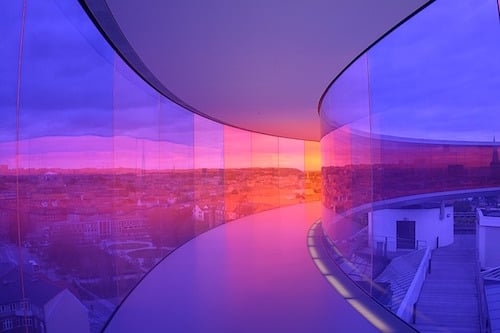8 Approaches for Innovative Windows
The window of the future is not merely a window. Innovative windows can change the market and business models. How the window market is already changing and will change.

Nowadays, a window does more jobs than just provide daylight and fresh air. The needs of users and the construction industry have changed. If harnessed correctly, new technologies and trends will open up opportunities for innovative windows.
When it comes to the utilization phase and building refurbishments in particular, industry expert Frank Lange (CEO of VFF Verband Fenster+Fassade e.V. in Frankfurt) sees huge potential for the window sector. He provided inspiration for innovative windows at theFensterbau Frontal 2022 trade fair.
I delved deeper into the topic and found 8 roles of innovative windows for you. The solutions for innovative windows address different target groups:
- Architects and builders
- Window manufacturers
- Trades responsible for installation, maintenance, and renovation
Innovative windows from the perspective of architects and builders
Getting plenty of daylight has positive effects on our health and well-being. Window spaces and a more transparent building envelope are therefore becoming increasingly more important in architecture. But what does an innovative window have to offer?
- Automation technology for smart windows: The entire envelope of buildings is becoming ever more efficient and better insulated; as is the case with functional components, such as the window. To ensure that the exchange of air between the interior and exterior provides a healthy living environment, innovative windows incorporate automation technology. Sensors record data (e.g. room temperature, CO2 levels, air quality), ensuring automatic ventilation. Although solar gain is beneficial in winter, in the summer automated shading must prevent overheating in the building. The installation of such innovative windows, which automatically regulate night cooling, fresh air, and shading, are a contribution to climate protection and should be considered in the planning.
- Solar gain and PV make windows innovative: Windows can be used for energy generation, with the help of photovoltaic glass for example. This opens up opportunities for owners to generate energy from almost any building envelope. The use of innovative, electricity-producing windows is still in its early stages. However, in combination with automation technology, such innovative windows offer a lot of potential. You are generating and conserving energy at the same time.
The sustainable and innovative windows industry
The simple design of windows gives users little idea of the complexity behind them. Digitalization, new technologies, and sustainability make for innovative windows from the perspective of manufacturers.
- Sustainable production: Reducing CO2 plays a key role for innovative windows from the window industry's point of view. Source materials, such as wood, aluminum, plastic, and glass, impact the CO2footprint, as does sustainable manufacturing, assembly, and reuse. By switching production to renewable energy, window manufacturers can reduce their product's CO2 footprint, among other benefits. Interest groups are already working on a quality seal that can be used to determine the sustainability of windows based on a catalog of criteria.
- Circular economy: In innovative windows, resources are used wisely. For example, EPPA members (European Trade Association of PVC Window System Suppliers) have agreed that by 2025 new products should be composed of an average of 25% recycled material. Disused plastic windows are recycled and the resources (PVC, glass, and steel) are made into new windows. For aluminum frame materials, too, there is already a well-established collection system with the A|U|F for almost entirely reusing scrap aluminum.
- Modularly conceived: More and more buildings will be renovated over the coming years; and this includes the replacement of windows. This is where Frank Lange sees an opportunity for the industry: "Innovative approaches to refurbishment, with renovated windows, 2-stage installations, or serial redevelopment concepts pick up on this trend and will also make it easier to replace windows in the future. This ensures cost-effectiveness during renovation, prevents noise and dirt, and is significantly more efficient."
The life cycle of innovative windows – installation, usage and renovation
- Smart self-check: Innovative windows not only support users with sensor technology, they also facilitate maintenance. RFID technology can provide data on window opening rates, which in turn indicate the need for maintenance. Innovative windows record when they have warped or are leaking. This information, stored in a cloud or directly on the chip, enables better maintenance and increases the service life of the windows.
- Simplifying installation: The challenge of the shortage of skilled workers is also being felt by the window industry. However, it can be solved with innovative renovation concepts or serial redevelopment measures. A high degree of prefabrication (wall and window delivered in one) could open a new way for window construction. If a complete component with pre-assembled windows, sun protection, and automation is installed on the wall, this means a simplification of the installation process – particularly for renovations.
Example: Such problems also lend themselves very well to the lead user method. With the plastics processor Rehau, for example, we were looking for solutions for assembly aids for simple and fast window assembly as part of a lead user project. - Innovating assembly steps: 2-stage assembly is a concept in which a window is installed in two steps. First, a preliminary frame (also called a blind frame) is installed, and later in the construction process the window. Frank Lange sees innovation potential in this assembly concept in two respects: On the one hand, the separated installation process reduces damage to the window during the construction phase. On the other hand, increasingly scarce skilled workers can be deployed in a more targeted manner. This is because skilled workers can be deployed specifically during initial installation, and subsequent refurbishment is much faster, easier, and significantly less time-consuming.
The innovative windows of tomorrow are holistically conceived
New technologies, market developments, and trends open up a wide range of innovation opportunities for the window, exterior door, and façade of tomorrow. From the approaches presented above, it is clear that innovative window designs require both product and process innovations – both in production and in window installation.
Lange sees great opportunity in terms of digitalization and sustainability: "On the one hand, to invest in more innovation – also in window and facade construction – and at the same time to further develop the processes from manufacturing, assembly, use to reuse. After all, efficient building envelopes are part of the solution for a climate-neutral building stock."











